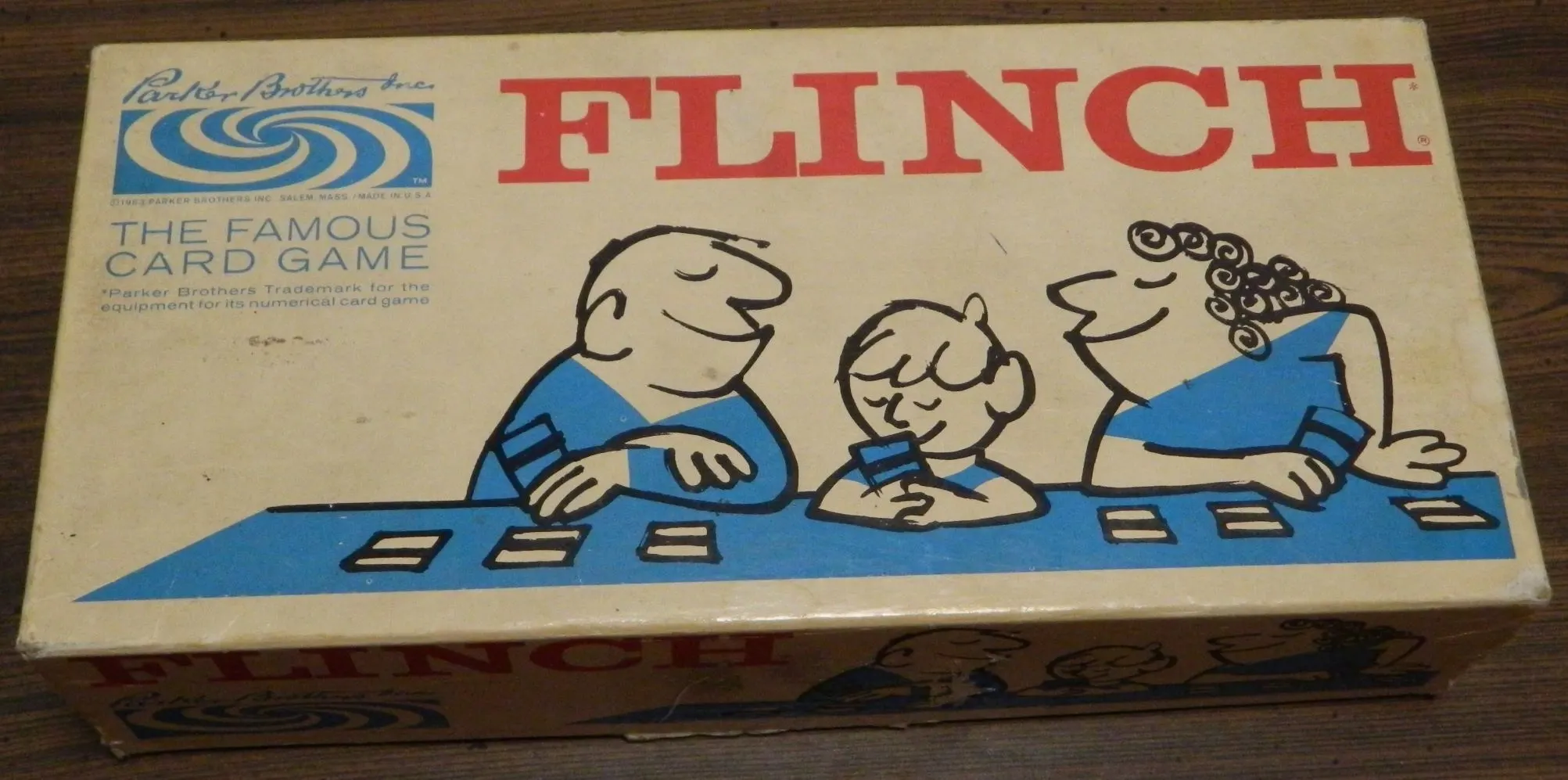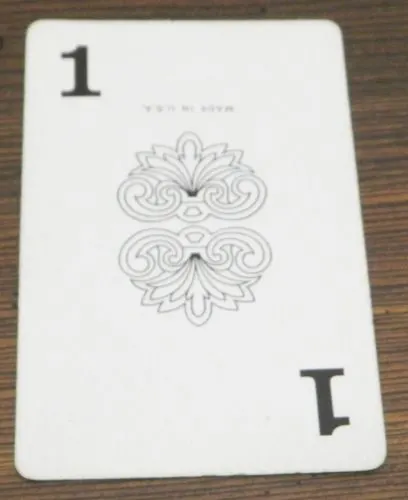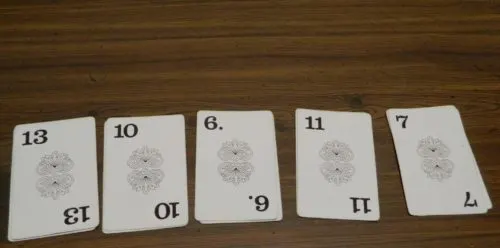Originally released back in 1903 Flinch is a card game that has always been pretty popular in my family. When I was younger many family members would regularly play the game. I even remember playing Flinch a lot when I was younger. Despite this fact I hadn’t played the game in a long time. Flinch is a game that belongs to a group of card games that share a very similar premise. Based on their age Flinch or Spite and Malice were probably some of the first even though these were also likely based off some older card games with similar premises. Later on came games like Dutch Blitz or the more famous Skip-Bo. I remember enjoying Flinch quite a bit when I was a kid so I was curious whether the game was going to still hold up now that I am considerably older. Flinch is far from a highly original card game, but it is simple enough that you can get some good mindless fun out of it.
How to Play Flinch
Terms
To make the rest of the rules easier to follow here are some terms that I will be using for the rest of the rules section.
Game Pile: At the beginning of the game each player will be dealt ten cards. These cards will be placed face down in a pile. The top card will be flipped over and placed on top of the other cards.
Hand: The cards held in your hand will be referred to as your Hand. You can look at these cards at any time, but you can’t show them to the other players.
Stack: The Stack consists of all of the cards that don’t make up the player’s Game Piles or Hands. These cards will be divided into groups of five and are crisscrossed in the tray. If the Stack ever runs out of cards take all of the piles that have been played to the middle of the table that have a fifteen on them and shuffle them to form the new Stack.
Reserve Piles: Each player will have their own set of five Reserve Piles. At the end of each player’s turn they will add a card to one of the five Reserve Piles. If a player has less than five Reserve Piles the next card they lay down has to form a new Reserve Pile.
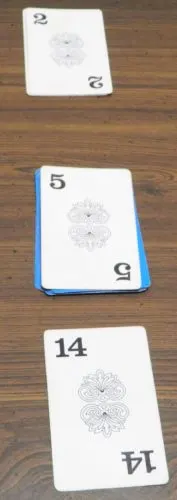
This player has finished their turn. They have decided to take the fourteen card from their hand and set it down to start their first Reserve Pile.
Once a player has five Reserve Piles any additional reserve cards can be played on top of any of the Reserve Piles. A player may never look at the cards below the top card in any of their Reserve Piles. A player can also never move a card from one Reserve Pile to another Reserve Pile.
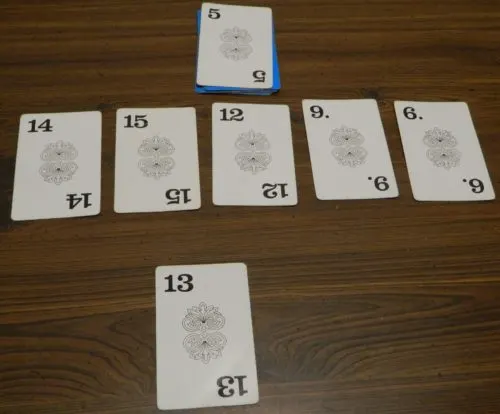
This player is done with their turn. As they already have five Reserve Piles they will place their next card on top of one of the five piles. This player has decided to place their thirteen card. A good place to place the card would be on top of the fourteen.
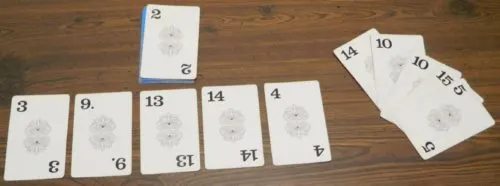
Here is an example of the setup in front of each player. The pile with a two on top of it is the player’s Game Pile. The five piles below the Game Pile are the player’s Reserve Piles. Finally the cards on the right are the player’s Hand (other players would obviously not be able to see these cards).
Setup
- Choose the player who will be the dealer. They will shuffle all of the cards together.
- The dealer will deal ten cards to each player to form the Game Piles.
- Five additional cards will be dealt to each player to form their Hand.
- The rest of the cards will be used to form the Stack.
- The player to the left of the dealer will start the game.
Playing the Game
To begin a player’s turn they must check their Game Pile and their hand for any one cards. If a player has a one card they must play it to the middle of the table to form another pile of cards.
After a pile has been started with a one the next card that will be played to the pile is a two and so on. This continues until a fifteen is added to the pile.
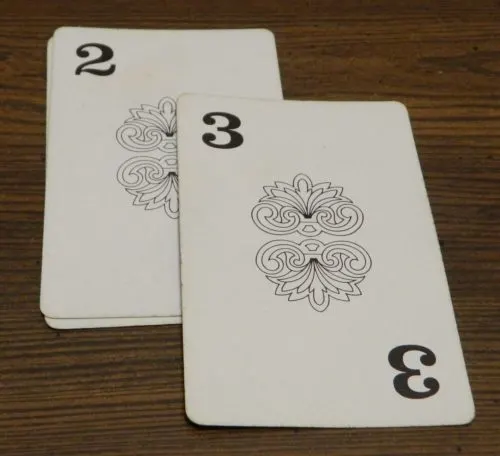
The current player has a three card that they would like to play. As one of the piles in the middle of the table has a two on the top, the current player plays their three card on top of it.
After checking for any ones the player will check their Game Pile, Hand and Reserve Piles for other cards that they can play. The player must play any cards that they can from their Game Pile, but they can choose not to play a card from their Hand or Reserve Piles.
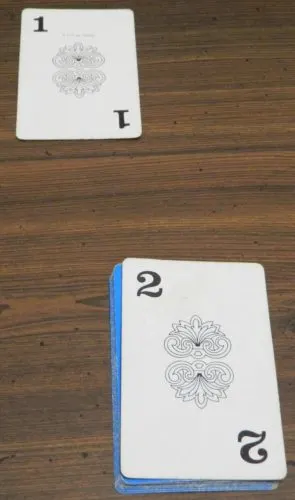
This player has a two on top of their Game Pile. This player must play it on top of the one card in the middle of the table or they will face a penalty.
If a player ever runs out of cards in their Hand they will take the top group of cards from the Stack.
When a player is done playing cards they will add one of the cards from their hand to one of their Reserve Piles following the rules mentioned above.
The one caveat to this is if at the beginning of the game this player wasn’t able to play a one card they won’t add a card to a reserve pile. This will continue until one of the players is able to play a one card. If none of the players are able to play a one card to start the game all of the players will lay down all of the cards from their Hand to start their Reserve Piles. Each player will then take a group of cards from the Stack. This will continue until someone is able to play a one card.
After adding a card to their Reserve Pile, play passes to the next player clockwise.
Additional Rules
Challenges
At the beginning of a player’s turn they must first play from their Game Pile if possible. If a player doesn’t do so another player can challenge them and the player who messed up must take a card from the challenging player’s Game Pile and add it to the bottom of their own Game Pile. The current player’s turn ends immediately.
A player can also challenge a player if they think they have a one card in their Hand and they didn’t play it. If the challenger was correct the challenged player will have to take a card from the challenging player’s Game Pile and add it to the bottom of their own pile. If the player didn’t have any ones in their Hand though the challenging player must take one card from the challenged player’s Game Pile and add it to the bottom of their own pile. If the current player was successfully challenged their turn ends immediately.
When multiple players challenge at the same time the player closest to the left of the challenged player gets credit for the challenge.
Accidentally Revealing Cards
If a player ends up revealing one of the cards from their hand they must try to play it. If they are unable to play it they will add it back to their hand. Their turn will then end immediately. If a player reveals a card during another player’s turn they must play it at the beginning of their next turn or they will lose their turn.
Stalemate
Occasionally you may reach a point where no one wants to play a card and the Stack is out of cards. If a player has a card that they don’t want to play but can, they will have to play it in this situation. If there are more than one player that can break the stalemate the first player that has a card that can break the stalemate must play it.
End of Game
The first player to get rid of all of the cards from their Game Pile wins the game.
Variants
Flinch has a number of variant rules that you can use to mix up the gameplay.
Players can decide to start piles in the middle of the table with ones or fifteens. Piles that start with fifteens will move downward and piles that start with ones will move upward.
Players can choose to start piles with eights. Players can then build in both directions from the eight.
If players want to play with partners the game plays the same except for a couple tweaks. When playing with a partner a player can also use cards from their partner’s Game Pile and Reserve Piles. If a player can play from both their own and their partner’s Game Pile they must first play from their own pile. Players can be challenged for not playing from either their own or their partner’s Game Pile, giving their partner information, not playing a one card, or looking under either player’s Reserve Piles.
Other Games
This is a list of some of the other games that you can play with the Flinch deck.
Muggins
Setup
Shuffle the cards and deal all of them out to the players. Each player will hold all of the cards in their hand face down.
Playing the Game
Starting with the player to the left of the dealer each player will take the bottom card from their hand and reveal it to all of the players. If the card is a one they will play it to the middle of the table which will start a new pile. Otherwise if the card is one higher than one of the piles in the center of the table they will play it to the corresponding pile. Once players have started forming Stock piles a player can play a card to another player’s stock pile if it is one higher or lower than the top card on the pile. When a player can play to center pile or another player’s Stock pile, they must play to a pile in the center of the table. If the player is able to play the card they drew they will then draw the next card and try to play it.
This will continue until they draw a card that they can’t play. They will place this card face up in front of themselves which will start their Stock pile. Play will then pass to the next player.
When a player is able to play the top card from their Stock pile they must play it. The player will play all of the cards that they can from their Stock pile before they can draw cards from the bottom of their hand.
If a player ever fails to play a card when they can another player can challenge them with the term “Muggins”. The player who failed to play the card will take the top card from the challenging player’s hand and add it to the top of their own Stock pile.
When a player has made it through all of the cards in their hand they will turn over their Stock pile which will form their new hand.
End of Game
The first player to get rid of all of the cards from their hand and Stock Pile wins the game.
Authors
Setup
Choose a dealer. The dealer will find four sets of cards numbered 1-15. They will shuffle all of the cards and deal them all out to the players. Players will hold the cards in their hand and can look at them at any time. The player to the left of the dealer will start the game.
Playing the Game
On a player’s turn they will ask one of the other players for a card of a specific number. To ask for a number the player must have that number in their hand.
If the asked player has the card they must give it to the asking player. The asking player can then ask any player for another card.
The current player can keep asking for cards until they ask for a card that the asked player doesn’t have. Play then passes to the next player clockwise.
Once a player has acquired all four cards of the same number they will lay them down as they have formed a “book”.
End of Game
The game ends when all of the books have been formed (the set of four cards for all fifteen numbers have been assembled). Players will count up how many books they have acquired. The player with the most books wins the game.
Patience (1 Player Game)
Setup
Find out four sets of cards numbered 1-15. Shuffle all of the cards and deal four cards face up on the table. If any of the face up cards are ones place them above the other face up piles. These cards will be referred to as the upper piles. The other piles will be referred to as the lower piles.
Playing the Game
Turn up one card at a time from your hand. You will try to add this card to one of the face up piles. If you draw a one card it will be added to the upper piles starting a new pile. If you have any one piles you will build up on the pile starting with a two and so on. All of the other piles you will build down on one number at a time.
If you can’t add a card to one of the face up piles you will add it to another face up pile referred to as your Stock pile.
In addition to taking cards from your hand you can also move cards from your Stock pile as well as the lower piles. You can play cards from any of these to one of the upper piles if they contain the next needed card. You can also combine lower piles together or add cards to lower piles. Whenever you have less than four lower piles you take the next card from your hand to form the next lower pile.
End of Game
The game ends when you have gone through all of the cards in your hand and can’t move more cards from the face up piles. If you have added all of the cards to the upper piles you have won the game. If one or more cards are left in the lower piles or your Stock pile you will lose.
Go To The Store
Setup
Take four sets of cards 1-15. Shuffle them and deal six cards to each player. The rest of the cards are placed face down in the middle of the table to form the Store. The player to the left of the dealer will start the game.
Playing the Game
On a player’s turn they will choose one of the other players and ask them for all of the cards they hold of a particular number. The player asking must have at least one of the card to be able to ask for a number. If the player has the number they must give the asking player all of the cards of that number that they currently hold. The current player can then ask a player for another number.
This continues until the player asks for a card that the asked player doesn’t have. The current player will then draw a card from the Store and play will pass to the next player clockwise.
When a player acquires all four cards of the same number they will play them in front of themselves.
End of Game
The game ends when all fifteen groups of four have been formed. The player that forms the most groups wins the game.
My Thoughts on Flinch
As I mentioned at the beginning of this review Flinch belongs to a group of card games that all share a very similar premise. If you are already familiar with Skip-Bo you should already know what to expect from Flinch as they are basically the same game. The only major differences between the two games are the distribution of cards and the fact that Skip-Bo features wild cards. While newer versions of Flinch also include wilds, older versions of the game do not. Other than Skip-Bo, games like Spite and Malice, Dutch Blitz and quite a few other games share basically the same gameplay as Flinch. For this reason if you are familiar with one of these games you should already have a good idea of what to expect out of Flinch.
For those not familiar with Skip-Bo or other similar games the easiest way of describing Flinch is to say that in many ways it feels like competitive Solitaire. Like Solitaire the game’s premise is to play cards that are progressively higher than the previously played cards. To do this you can play cards from your hand, reserve piles, or your game pile. The ultimate goal of the game is to get rid of all of the cards from your game pile in order to win the game.
If that sounds simple it should as Flinch is not a particularly complicated game. In order to play the game you basically just have to be able to count up to 15. If the players are familiar with other similar card games you should be able to teach the differences in Flinch within just a couple minutes. Those with no familiarity with the subgenre of card games should still be able to learn the game in maybe five minutes.
With the game being so simple it should come as no surprise that Flinch is the type of game that I refer to as mindless fun. Flinch will never be considered a particularly deep game. The game has a little more strategy than you would initially expect (more on this later), but it isn’t really a game where strategy plays a large role. Flinch is more the type of game that you play when you don’t want to put too much thought into what you are doing. It is a conversation game as you don’t have to think too much at any particular time. Most of the decisions are really obvious and in some ways the game plays itself. Despite this Flinch can still be enjoyable as it is still fun being able to get rid of a bunch of cards on your turn.
With the game mostly being mindless fun it isn’t surprising that the game relies on a lot of luck. People who have played the game a bunch will have somewhat of an advantage in the game as they will know how to address certain situations. Most of the time though your fate in the game is likely going to depend on what cards you are dealt and what cards are currently in the middle of the table. You can have the best strategy and have no chance of winning if you aren’t dealt the right cards. In particular you need to be dealt good cards for your game pile. You generally want lower cards or cards that work with the current top cards in the middle of the table. The winner of most games will come down to which player is lucky enough to get several cards in their game pile that are easy to get rid of. Whoever is dealt the best game pile at the beginning of the game will likely have a pretty big advantage in the game.
While a large amount of the game will be decided by the luck of the draw, there are some opportunities for strategy in the game. The strategy is not enough to overcome bad luck, but if two players have similar luck the player with the better strategy will likely win. Most of the strategy in the game comes from choosing when to play cards and when to hold them back. You must play any one card or any card from your game pile that can be played, but otherwise you can choose when you want to play a card. Most of the time you don’t want to play a card unless it will help you play a card from your game pile or block another player from playing a card from their game pile. There are a few situations where it may pay to take a chance and play cards that may not directly help you though. Basically before deciding on whether to play a card you need to figure out if it will help the other players. If it will help another player you probably shouldn’t play the card. This can lead to some moments where there is a stalemate as players don’t want to play cards that will help their opponents. These situations usually work themselves out, but if they don’t a player is forced to break the stalemate.
Other than choosing when to play cards the other area where strategy comes into play regards the reserve piles. The reserve piles are kind of interesting as how you choose to add cards to the piles can have a pretty big impact on how well you do. When you don’t have all five reserve piles set up this decision is pretty obvious as you just need to play a card to start the next pile. Once you have the five piles though things become more interesting. You need to figure out which pile you should cover up. Most of the time you want to play a card on top of another card if it is one lower as this allows you to play the top card and then the card underneath as well. As your piles grow though it also introduces a memory element as you try to remember what is in each pile. At first it is pretty easy to remember what is in each pile, but as players start to stalemate you will get to the point where you only have a vague idea of what is in each pile. Having a good memory can really help you in the game as you can remember if you have useful cards in one of your reserve piles.
Many games in this subgenre of card games can be played with a standard deck of playing cards. In a way you could play Flinch with a standard deck of playing cards as well (preferably two decks) even if the card distribution will be a little off. I mostly bring this up because the distribution of the deck makes Flinch the type of game that can be used for a number of different games. As Flinch has been around for over 100 years the game has accumulated quite a few variant rules and other games that you can play with the cards. I listed some of them above in the rules section, but the game has added others throughout the years. Of the variant rules above I tried playing the game with the “eights” rule and I have to say that I wasn’t a big fan of it. I thought being able to play above and below the eights would add an interesting twist to the game, but it mostly just made it more confusing than it needed to be. Many of the variant rules don’t drastically change the gameplay, but they do add some potential variety to the game.
With the game being over 100 years old it should not be surprising that the component quality is going to vary depending on which version of the game you are playing. Many of the versions are similar, but there have been some changes over the years. The older versions of the game contain ten sets of cards 1-15 while some of the newer sets have less cards while also including wild cards. As for the version of the game that I used for this review (1963) I would say that the components are pretty much what you would expect. The artwork is pretty basic, but it is also simple and to the point.
Should You Buy Flinch?
Being over a hundred years old you are always a little cautious about games like Flinch as most games that old aren’t particularly good anymore. Flinch is far from a great game, but it is not bad either. Similar to many other games like Spite and Malice and Skip-Bo, Flinch is basically competitive Solitaire. Players compete to get rid of all of the cards from their game pile. This leads to a really simple game as you just play cards on top of one another that are one number higher. This leads to a pretty mindless game that can still be pretty fun. There is some strategy to the game as you determine when to play cards and how to build your reserve piles. The more you play the game the better you should get at it. The luck of the draw is still likely to determine who ultimately will win the game. Flinch is far from a deep game, but you can have some fun with it if you just want something that is easy to play and don’t really care who ultimately wins.
If you have played games like Skip-Bo or Spite and Malice and don’t really care for them, you likely will have similar feelings towards Flinch as they are basically the same game. People who don’t really care for simple card games likely won’t get much out of Flinch either. If you have fond memories of Flinch though or are looking for a simple mindless card game you can do a lot worse than Flinch. At a good price I think it is worth checking out Flinch.

